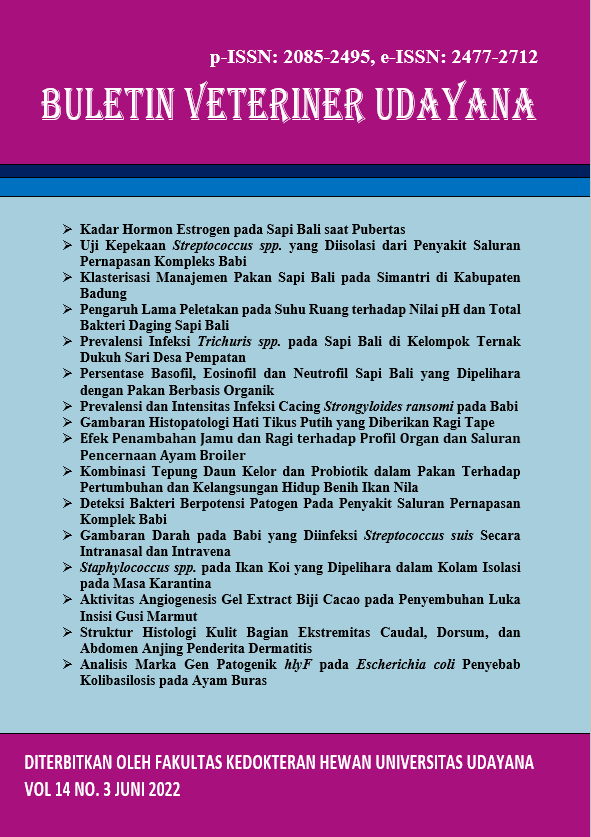STAPHYLOCOCCUS SPP. BACTERIA IN KOI FISH REARED DURING QUARANTINE PERIOD
Abstract
Currently, koi fish enthusiasts and fans in various regions in Indonesia, especially in Bali, have increased very sharply. In the conditions of transportation from outside Bali to Bali, it triggers stress which causes the koi's resistance to decrease so that disease occurs. Therefore, a quarantine process is very necessary to get koi that are healthy and suitable for cultivation. Diseases in koi fish can be caused by viruses, parasites, and bacteria, one of which is Staphylococcus spp. Research on bacterial infections in koi fish is still very rare, especially regarding Staphylococcus spp. in koi fish in Indonesia and in Bali. This study was conducted to obtain preliminary data regarding Staphylococcus sp infection in koi fish. In this study, the object used was koi fish which has any symptomps of diseases or died during a 14-day quarantine period.The researched koi fish came from suppliers in Tulungagung and Blitar, East Java. The size of the koi fish ranged from 15 -25 cm which was kept in fish isolation ponds at Raka koi and Tilapia Farm, Denpasar. The samples taken were 19 samples, the 8 samples are thescale swabs from koi fish from Tulungagung and 11 scale swab samples from koi fish from Blitar using random sampling technique. Staphylococcus sp was isolated with Blood Agar and MacConkey Agar media and identified by Gram stain test and catalase test. From the results of the isolation and identification of bacteria, 1 sample was positive for Staphylococcus spp. (5.26%).
Downloads
References
Arthur JR. 2004. The role of quarantine in preventing the spread of serious pathogens of aquatic animals in Southeast Asia. Transboun. Fish Dis. Southeast Asia: Occur. Surveillance, Res. Train. Pp. 25-33.
Barton BA. 2002. Stress in fishes: A diversity of responses with particular reference to changes in circulating corticosteroids. Integ. Comp. Biol. 42(3): 517-525.
Bujjama P, Padmavathi P. 2015. Prevalence of Staphylococcus aureus in the fish samples of local domestic fish market. Int. J. Cur. Microbiol. Appl. Sci. 4(5): 427-433.
Carneiro P, Urbinati E, Bendhack F. 2007. Osmoregulation and fish transportation. Fish Osmoregulation. Pp. 235-248.
Chyan JM, Yang CC, Lin C, Chen IM, Yeh J. C. 2012. Investigations of water purification performance for aquarium water filters. Sustainable Environ. Res. 22(6): 363-370.
De Kock S, Boris G. 2015. Japanese Ornamental koi Carp: Origin,Variation, and Genetics. Kentucky.
Dordet-Frisoni E, Dorchies G, De Araujo C, Talon R, Leroy S. 2010. Genomic diversity in staphylococcus xylosus infection in mice deficient in NADPH oxidase and comparison with other laboratory mouse strains. J. Am. Assoc. Lab. Anim. Sci. 49(4): 480-486.
Harper C, Wolf JC. 2009. Morphologic effects of the stress response in fish. Oxford Acad. J. 50(4): 387-396.
Kusnadi Y, Hamdiyati AF. 2003. Mikrobiologi. Bandung: FMIPA Universitas Pendidikan Indonesia.
Kusuda R, Sugiyama A. 1981. Studies on characters of Staphylococcus epidermidis isolated from diseased fishes. The morphological, biological, and biochemical properties. Fish Pathol. 16: 15-24.
Oh W, Jun J, Giri S, Yun S, Kim H, Kim S, Park S. 2019. Staphylococcus xylosus infection in rainbow trout (Oncorhynchusmykiss) as a primary pathogenic cause of eye protrusion and mortality. J. Microorg. 7(9): 330.
Piper RG. 1982. Fish Hatchery Management. Washington DC: Departement of the interior: Fish and wildlife.
Randall D, Tsui T. 2002. Ammonia toxicity in fish. Mar. Pollut. Bul. Pp. 17-23.
Rifai MR, Widowati H, Sutanto A. 2020. Sinergisme dan antagonisme beberapa jenis isolat bakteri yang dikonsursiumkan. Biolova. 1(1): 21-26.
Singh B, Kulshreshtha SB. 1994. A study on prevalence of Staphylococcus aureus in fish and fish products and their public health significance. Indian J. Comp. Microbiol. Immunol. Infect. Dis. 14(3-4): 25-28.
Stewart CM. 2003. Staphylococcus aureus and staphylococcal enterotoxins. A. D. Hocking, Foodborne microorganisms of public health significance. Sydney: Institute of Food Science and Technology (NSW Branch). Pp. 359-380.
Stone NM, Thomforde HK. 2003. Understanding Your Fish Pond Water Analysis Report. Arkansas: University of Arkansas.
Strange RJ. 1980. Acclimation temperature influences cortisol and glucose concentrations in stressed channel catfish. Trans. Am. Fish. 109(3): 298-303.
Watson CA, Hill JE, Pouder DB. 2004. Species Profile: koi and Goldfish. Southern Regional Aquaculture Center.
Weerakkody N, Caffin N, Dykes G, Turner M. 2011. Effect of antimicrobial spice and herb extract combinations on Listeria monocytogenes, Staphylococcus aureus, and spoilage microflora growth on cooked ready-to-eat vacuum-packaged shrimp. J. Food Protect. 74(7): 1119-1125





